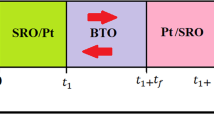Abstract
By making a combination of both point contact and barrier type tunnel junctions on a single sample of the highT c superconductor BSCCO (2212) single crystal, we have shown that as the tunneling tip is slowly retracted from the surface a point contact junction gradually evolves from a N-S short to a high resistance tunnel junction. The scaled dynamic conductance (dI/dV) of this point contact tunnel junction becomes almost identical to that of a conventional barrier type tunnel junction and both show a linear dI/dV —V curve. The observation implies that at high resistance a point contact junction behaves in the same way as a barrier type tunnel junction. We suggested that the almost linear tunneling conductance obtained in both the cases most likely arises due to an intrinsic characteristic of the surface of the crystal comprising of a mosaic of superconducting regions of the order of a few nanometers. We also conclude that the barrierless (N-S) point contact obtained by piercing the surface oxide layer of the crystal shows Andreev reflection which we suggest as the origin of the zero bias anomaly often observed in point contact junctions.
Similar content being viewed by others
References
Blonder G E, Tinkham M and Klapwijk T M 1982Phys. Rev. B25 4515
Cucolo A M, Valles J M Jr, Dynes R C, Gurvitch M, Phillips J M and Garno J P 1989Physica C161 351
Edgar A, Adkins C J and Chandler S J 1987J. Phys. 20 L1009
Kirtley J R 1990Int. J. Mod. Phys. B4 201
Kirtley J R, Tsuei C C, Park S I, Chi C C, Rozen J and Schafer W M 1987Phys. Rev. B35 7216
Qiang Huang, Zasadzinski J F, Gray K E, Bukowski E D and Ginsberg D M 1989Physica C161 141
Sharvin Yu V 1965Zh. Eksp. Teor. Fiz. 48 984 (Sov. Phys. JETP 21 655)
Shivashankar G V and Raychaudhuri A K 1990Pramana - J. Phys. 35 L503
Srikanth H and Raychaudhuri A K 1991aPhys. Rev. B (submitted)
Srikanth H, Rajeswari M and Raychaudhuri A K 1991aPramana — J. Phys. 36 207
Srikanth H and Raychaudhuri A K 1991bCryogenics (to appear)
Srinivasan R1990 Review article of talk delivered at the discussion meeting on highT c superconductors, Bangalore August 90
Wolf E L (ed.) 1985Principles of electron tunneling spectroscopy (Oxford: University Press)
van Bentum P J M, van Kempen K, van de Leemput L E C and Teunissan P A A 1988Phys. Rev. Lett. 60 369
Zeller H R and Giaever I 1969Phys. Rev. 182 789
Author information
Authors and Affiliations
Rights and permissions
About this article
Cite this article
Srikanth, H., Raychaudhuri, A.K. A comparison of barrier type tunnel junction and point contact tunnel junction formed on the same highT c material. Pramana - J Phys 36, 621–627 (1991). https://doi.org/10.1007/BF02845800
Received:
Revised:
Issue Date:
DOI: https://doi.org/10.1007/BF02845800
Keywords
- Point contact
- tunneling
- cryogenic scanning tunneling microscope
- Andreev reflection
- oxide superconductors




